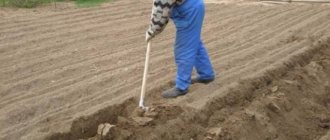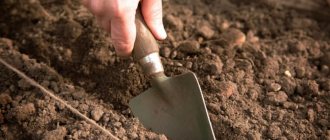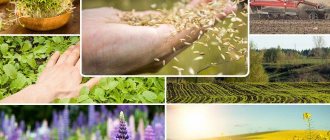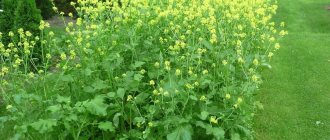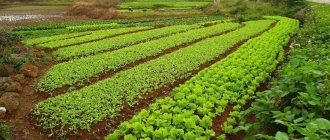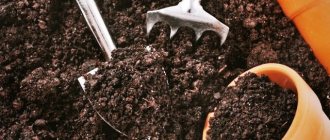After a busy summer season, I want to relax as soon as possible and, if possible, reduce the list of work. One of them - digging up the earth in the fall - was until recently carried out by all gardeners and was considered very important.
And now the question increasingly arises: is this really a necessary procedure, is it worth spending time and effort on it, or can you get by with just spring digging? So, let's finally find out whether it is necessary to dig up the garden in the fall and understand all the intricacies of this work.
Preparing beds in the fall for the new season is one of the most important conditions for obtaining a rich harvest. Over the winter, the soil is saturated with minerals that were added during digging. Snow saturates the beds with moisture faster, while the dug-up soil itself does not become compacted. As a result, in the spring it is much easier to carry out preparatory work before planting. Significantly save energy and time.
Digging up the earth for the winter
It is imperative to dig up your garden in the fall before the coming winter. This procedure is necessary to prepare the soil. In the autumn season, during the digging period, the ideal period begins for fertilizing with manure, composts and humus. Also, in farms where planted crops are regularly attacked by the Colorado potato beetle, mole cricket, wireworm and other types of pests, digging up the soil will be relevant. The procedure allows you to destroy the larvae hidden in the soil. To do this, plow the ground to a depth of 25 cm.
What benefits does cultivating the land in autumn provide?
Every gardener and gardener has a separate opinion as to whether it is necessary to dig up your garden in the fall. Not everyone knows why the earth is being dug up. Some refuse this procedure, while others, on the contrary, completely cultivate their land. You must first study the advantages and disadvantages of this procedure, and then decide whether you need to dig up the soil in the fall in your garden. Tips from experienced gardeners will help you understand the intricacies of digging.
Pros and cons of digging
The main advantage of the procedure is the ability to cultivate the site, enrich it with minerals and organic substances, and loosen the soil. In addition, this is an excellent method of controlling weeds, which germinate well in the warm autumn. We must not forget about the disadvantages of plowing. The procedure is quite difficult and takes a lot of time and effort. There is no need to dig in areas where it is not required.
The soil is home to a large number of worms, spiders, various microorganisms and fungi. Under a microscope, even on a small piece you can see billions of living microorganisms. They live at different depths. During the opening and turning over of the soil, local residents change places, some die.
The value of soil lies in its inhabitants. The more there are, the more fertile the land becomes. Therefore, debates about whether it is necessary to dig up your garden in the fall do not subside even among agronomists.
Weed control
Weed control by weeding, even in a small area, requires a lot of time. Digging up fertile soil helps to effectively fight weeds. However, it should be borne in mind that it will not be possible to completely get rid of them, but plowing the area will significantly weaken the development of the weed.
In addition, in addition to weed seeds, there will be fungi and other pathogenic bacteria on the soil surface that affect crops grown in the garden. Since cold weather begins in the fall, all microorganisms will die at low temperatures. Therefore, digging the soil in the garden is the best way to disinfect it.
Dependence on soil type
In order to understand whether it is necessary to dig up the garden in the fall or in the spring, you need to find out what type of soil is in the garden. At a summer cottage located in a region with heavy clay soils, fertility can be increased mechanically. However, you need to dig the soil without breaking up the lumps. After snow falls, pieces of soil will begin to become saturated with oxygen. In spring, the soil will be more loose and supplied with nutrients. For wet soil, fertilizers are not so important, so with this type of soil it is better to dig up the beds in the spring months so that the remaining moisture evaporates.
How to properly dig up the soil in the fall in the garden
Depending on the crop that will be planted next year, select the appropriate depth for digging the soil:
- 25-30 cm (per spade blade) – for potatoes, beets, carrots, pumpkins, melons and parsley;
- 5-10 cm – for tomatoes, cucumbers, peppers, radishes and legumes.
It is advisable not to turn the soil layers over, but to transfer them among themselves in order to preserve as much beneficial microflora as possible. It is better to remove the roots of weeds rather than bury them. It is much easier to carry out such digging. But if the soil is very hard and rocky, you will have to do two-tier digging with two shovels. And here it is no longer possible to do without turning over the layers of soil. But resorting to such digging should only be done as a last resort.
A shovel, fork or cultivator are suitable tools for digging.
Shovel. Used on small plots of up to 10 acres. A budget option that will cope well with different types of soil, but is quite labor-intensive.
Pitchfork. They allow you to achieve a finer soil structure, which young plants like, but is not always achieved with a shovel. It also requires effort.
Cultivator. The soil quickly becomes loose, plant roots feel great in it. It will save time and effort when working on a large area, but it will not cope with very heavy soils, and it is not cheap. If the garden requires digging, but there is no way to do it, sow green manure. They will loosen the soil to a depth of 2 m, saturate it with useful elements and reduce the activity of pathogenic microflora. And in winter they will hold snow well and prevent the beds from freezing.
Whether to dig a garden in the fall is up to each summer resident to decide for himself. If you have heavy clay soil on your site, then it is better to dig, but if it is loose and light, you can only get by with a spring procedure, replacing autumn digging with deep loosening. To reduce the load on soil microflora, dig once every few years as necessary.
Disadvantages of digging
Opponents of autumn digging, and these are most often adherents of organic cultivation of the land, have their own arguments. They consider it useless and even harmful, and here's why:
- On the surface are not only weed roots, debris and pests, but living organisms, whose vital activity benefits the ecosystem and increases soil fertility. Winter frosts will leave them no chance of survival.
- Fertility also suffers due to disruption of the soil structure. When digging, the bottom layer is removed to the surface, but it is not so fertile.
- There is no guarantee of getting rid of weeds - roots and seeds. Many of them are frost-resistant and will survive the winter well.
- Digging is hard physical work, sometimes simply too much for older people. At the end of the summer season, people want to relax rather than engage in physical labor.
What fertilizers to apply to the ground in the fall
One of the stages of soil treatment, which is carried out together with digging or loosening, is fertilizing the soil, which will increase its fertility and saturate it with nutrients. This procedure is especially necessary for loamy and clayey soils, which in winter become so compressed that practically nothing grows on them.
Along with digging, you need to add fertilizer to the soil.
They need to be dug up in the autumn and one, and sometimes several, types of fertilizers applied. The procedure requires compliance with certain conditions, primarily the amount and frequency of adding nutrients.
Soil fertilizers
| Manure and droppings | They increase soil fertility, but require caution when applying - if you simply bury such fertilizers under plants, you can burn their roots | Such fertilizers need to be incorporated into the soil once every 3-4 years, 3-4 kg per square meter of garden. |
| Compost | Compost is a mass of decomposed organic waste that is “grown” in special containers. It may consist of vegetable peelings, grass clippings, tops, thin branches, etc. It takes 1-2 years for compost to mature well - after being added to the soil, it slowly decomposes and enhances the positive qualities of the soil | Compost is applied in the autumn, the optimal amount is 1-2 buckets per square meter of soil |
| Green manure | Green manure is the most environmentally friendly and cheapest type of fertilizer. These are plants that are sown in the summer, and in the fall the grown sprouts are simply embedded in the soil. They improve the water and air permeability of the soil, saturate it with nitrogen, and help fight pathogenic microorganisms and pests. The best proven legumes, cruciferous and cereal crops are clover, lupine, mustard, rapeseed, and rye. | The specifics of fertilizing the land with green manure depend on the chosen crop, but it is important not to let the plant overgrow (the height should be no more than 10 cm), otherwise it will decompose much worse |
| Peat | Peat contains a large amount of organic matter, and in addition, it retains liquid well in the soil. It is best to mix it with compost and incorporate the resulting mixture into the soil. | Peat is added to the soil at the rate of 30-40 kg per square meter |
| Ash | Ash is a universal fertilizer that contains a large amount of minerals, neutralizes acidity and repels harmful insects. As a top dressing, you can only use natural ash obtained after burning firewood or plants. | The amount of ash that needs to be added to the soil in the fall depends on the crop - on average 1-2 cups per square meter. As in the case of manure, you can fertilize the soil with ash once every 3-4 years. |
| Sawdust | Sawdust, chopped grass and tree bark are used to loosen too dense soils and retain moisture in sandy soils. They gradually decompose, resulting in the formation of compost. It is best to mix sawdust with other types of fertilizers - manure, bird droppings, urea, to create a nutritious mixture that is left to rot | The amount of sawdust that needs to be added to the soil depends on the crop being fertilized and additional components of the mixture |
| Mineral fertilizers | Mineral complexes are sold in specialized stores in ready-made form - there are many special formulations intended for different crops. They must contain a minimum of nitrogen - usually the packages are specially marked “autumn” or “for autumn use” | The conditions and amount of mineral fertilizers applied to the soil can be found in the instructions. It is strictly not recommended to exceed the dosage - it is better to underfeed the soil than to overfeed it |
| Potash fertilizers | Most potash fertilizers contain chlorine, but over the winter its negative effects are neutralized, so it is recommended to apply such substances in the fall. Along with potash fertilizers, many gardeners add phosphate mixtures to the soil. | The amount of potash fertilizers depends on their type and the crop that will grow in a certain area - from 0.1 to 0.4 kg per hundred square meters |
Soil structure
Autumn is the most favorable time to improve the soil structure on your site.
If the soil on the site is clayey, very dense
then in the fall it is very good to add wood ash, sand, and leaf compost in addition to fertilizers. These substances will make the soil very loose, more air- and moisture-permeable.
If your site has light, sandy soil
, very fluffy, does not retain moisture and nutrients well, then it is necessary to add compost, which will make the soil more dense, you can also add sawdust, which will accumulate water and hold it longer.
If your site has too acidic soil
, in the fall you can add substances that will make the soil more neutral, suitable in acidity for most garden plants. To do this, add dolomite flour, chalk, and lime for digging. This operation must be carried out every year, adding small doses of these substances.
Video - Autumn tillage
Is it necessary to dig up the soil in a greenhouse in the fall?
Experienced gardeners advise to completely replace the layer of fruit-bearing soil every year. To do this, the top 10-15 cm must be removed and new soil brought in. Not everyone understands why this needs to be done. Thus, it will be possible to increase productivity and reduce the risk of developing soil and plant diseases. Even with an understanding of the importance of soil replacement, not everyone succeeds in doing this. In this case, digging up the beds becomes the best option. It is necessary to carefully select all remaining plant roots and insect larvae.
During this same period, gardeners prefer to apply fertilizers. Its type depends on the plants that will be grown in the greenhouse.
To improve soil fertility and its structure, gardeners plant mustard in the greenhouse after harvesting the entire crop. It not only allows you to increase the productivity of other crops, but also effectively copes with the harmful microflora that exists in the soil.
It all depends on the climate
Climate also affects the condition of the soil. In warm regions, the soil usually dries out faster, so it does not need frequent digging. On the contrary, it can worsen the condition of the soil, so it will not have time to absorb moisture during the winter. In regions with a cold and humid climate, it is necessary to dig up the soil. Due to natural conditions, the soil here becomes very compacted in winter. This reduces soil fertility and makes it unsuitable for growing some plants.
Lost weight: what Sofia Tarasova sacrificed for the sake of “VIA Gra” (new photos)
Women's jeans: before you buy them, you need to pay attention to one detail
Smooth and fresh skin: dermaplaning, or why a woman needs to shave her face
Proponents of organic farming often cite the example of forest ecosystems, where plants grow well without digging or fertilizers. But it is worth remembering that they are less demanding on soil quality. Varietal and hybrid vegetables will not be able to survive in such conditions.
When is it better to plow the garden: in spring or autumn?
Gardeners have different opinions about when is the best time to dig up the beds. Experienced specialists explain why this procedure should be carried out in the autumn. This will greatly benefit the soil. It is necessary to dig up the beds in those areas where the soil itself is poor. When the soil turns over, weeds freeze out over the winter, pathogenic microorganisms die, which lead to diseases of the crops grown in the garden. Annual digging in the autumn months will increase the yield, and the number of problems during its cultivation will decrease.
If you were unable to dig up your garden in the fall, you can do this after the snow has completely melted and the ground has become soft, ready for the upcoming loosening. It is carried out taking into account a number of rules:
- the soil should not be frozen;
- It is necessary to dig up the area in furrows;
- during loosening, you need to carefully break up the lumps;
- In the spring, it is best to cultivate the garden with a shovel. It will help loosen the soil well and break up the lumps that form.
